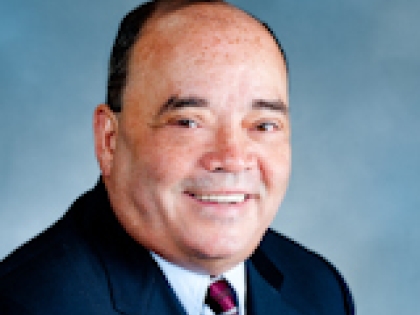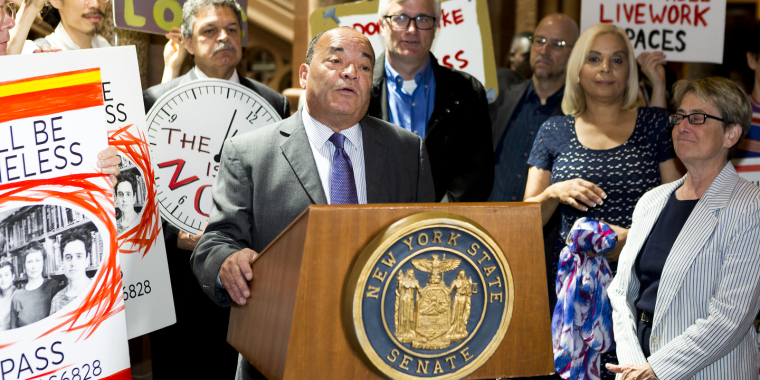
Senator Dilan Memo on LATFOR Guidelines & Criteria
Martin Malavé Dilan
July 5, 2011
To: Senator Michael F. Nozzolio, Assembly Member John J. McEneny,
Assembly Member Robert Oakes, Welquis R. Lopez, Dr. Roman Hedges
From: Senator Martin Malavé Dilan
Date: July 6, 2011
Re: 2011-2012 LATFOR Agenda Items
Hearing Schedule: Locations
Hearing Schedule: Hours and Time Allotments
Hearing Record
Prison Population Reallocation
Racial Bloc-Voting Analysis
Size of the Senate
Redistricting Criteria
Hearing Schedule: Locations
A public hearing should be held in Nassau County. Hearings have been announced for Albany, Rochester and Syracuse. During the previous redistricting cycle, hearings were held also in Buffalo, Binghamton, Albany, White Plains, Hauppauge, and all five boroughs of New York City – but not in Nassau County. A ‘Long Island’ hearing held only in Suffolk County is not sufficient. Nassau is the sixth most populous county in the state – substantially more populous than Westchester, and with nearly three times the population of Richmond. It requires more time and effort for Nassau residents to go to Hauppauge than for New York City residents to travel to another borough.
A hearing should be held in Mineola. The large public turnout for the recent Nassau County Legislature’s redistricting hearings and meetings shows that there is keen public interest in redistricting in Nassau County. According to the New York Times (May 15), it took ten hours to hear from every person who testified in Mineola on May 9th. CBS News (May 16) estimated the public attendance at the hearing at 300. If LATFOR schedules no hearings in Nassau, it will be impossible to avoid the conclusion that LATFOR deliberately chose to make it difficult for Nassau residents to make their voices heard on the redistricting of the State Legislature and Congress.
Hearing Schedule: Hours and Time Allotments
It has been LATFOR’s practice to schedule hearings in the morning, as has now been done with the Albany, Rochester and Syracuse hearings. Experience shows that hearings on redistricting attract testimony not only from those professionally involved in the subject, or with a special personal interest, but from the general public. Many persons who might wish to testify have jobs and are unable to attend meetings during the day. Past New York City Districting Commissions hearings were held in the evening and LATFOR should follow their example. To accommodate all who wish to testify, LATFOR should consider opening each hearing in the early afternoon, taking a dinner break (unless there are still persons waiting to testify), and resume at an announced time in the early evening
Occasionally groups of witnesses offer their testimony en masse. In such cases, although each witness should be held to the five-minute time limit, each witness should be entitled to his or her full five minutes. There is no reason that two or three witnesses should be limited to five minutes in total because they have presented themselves as a single panel.
Hearing Record
During the previous (2002) redistricting round, hearing transcripts were posted on the LATFOR web site. Statements submitted in writing, while available to the members and staff, and included in the documentation of the VRA §5 submission, were not readily available to the public. Statements submitted in writing – whether in person or received in the mail – should be scanned to create PDF documents, and those documents should be posted on the web site along with the hearing transcripts. Guidelines could be provided for submitting scannable documents, and the public could be encouraged to submit written statements in printed and electronic format. Since written testimony and letters are likely to have been created with word-processing software, this should be convenient for LATFOR and for the public. The same procedure should be followed for making redistricting proposals received from the public available to the public.
Prison Population Reallocations
Legislative Law §83-m (13) requires LATFOR to develop a redistricting database in which prisoners in federal and state custody have been subtracted from their place of incarceration, and in which prisoners in state custody are, to the extent possible, reallocated to their prior residential addresses. LATFOR is bound by this law, and does not enjoy the discretion to ignore it or to delay its implementation. Although there is litigation concerning the constitutionality of the law, no temporary restraining order or injunction has been issued. Absent an order from the Court, LATFOR does not have the authority to proceed as though it had been enjoined from executing the law.
Last year LATFOR staff was working on the required reallocation of prisoners in state custody, but that work apparently came to a halt in January. The Census Bureau has since made available an Advance Group Quarters Summary File, for the express purpose of helping New York State and other jurisdictions to subtract prisoner populations from their place of incarceration. More detailed information will be available when the Census Bureau issues Summary File 1 for New York State this summer.
My staff can provide to LATFOR a determination of the required subtractions, at the block level, based on the Advance Group Quarters Summary File and other data sources (which were used to distinguish prisoners in federal and state custody from those in local jails). These determinations should be revisited when Summary File 1 becomes available, but are not likely to require much revision (if revision is required).
Only LATFOR staff, however, can make the legally mandatory reallocations, since that requires the use of confidential information provided to LATFOR by the Department of Corrections and Community Supervision, pursuant to Correction Law §71 (8). LATFOR staff must be instructed to resume this work immediately, and to complete it as soon as reasonably possible. LATFOR is required by law to do so.
If subsequent judicial rulings prohibit the use of the amended database for legislative redistricting, it can be set aside, and no harm will have been done. But in the absence of such rulings, further delay may seriously disrupt the redistricting process. LATFOR is also required by law to make this database available to local governments, which are required by the Municipal Home Rule Law to use it in redistricting or reapportioning local legislative bodies. Ongoing litigation does not challenge this provision of the Municipal Home Rule Law, except as to the method of enactment. LATFOR should also make the amended database—including all mandatory subtractions and reallocations—available to the public as the basis for legislative redistricting proposals to be submitted. Genuine public participation in the redistricting process will be impossible if the amended database is not completed and made available in good time.
Racial Bloc Voting Analysis and Political Database
In 2002, LATFOR commissioned expert consultants to prepare a racial bloc-voting analysis to determine whether certain senate districts in New York City would provide minority group voters with the opportunity to elect representatives of their choice.[1] The report did not become generally available, however, until the application was made for VRA § 5 preclearance of the already-enacted legislation.[2]
Any such report should be made public as soon as it is available, and should be made available to all members of LATFOR and of the Legislature for the proper evaluation of the redistricting legislation. It should be completed early enough so that it is not merely retrospective.
The 2002 report evaluated districts drawn in Queens County, as well as in the three counties subject to VRA §5 preclearance. This was appropriate, since the Legislature’s responsibility to provide fair representation to minority groups is not limited to preclearance counties. For that reason, any such analysis should be extended not only to Queens County, but to every county in which the minority group population is significant in proportion to the mean population of senate or assembly districts.
The 2002 report analyzed several elections that were not part of the generally available LATFOR political database. Any political database compiled for the purpose of such a racial bloc-voting analysis should be made generally available.
The LATFOR political database should now be made publicly available on the LATFOR website for use by any persons who may wish to make redistricting proposals to LATFOR, or to use the database to evaluate LATFOR’s eventual proposals.
Size of the Senate
The size of the Senate can be established at this time. The county population totals provide all of the necessary data.
During the last redistricting round, the Senate Majority: 1) announced on the Task Force web site, beginning in the spring of 2001, that the Senate would have 61 districts, and solicited proposals from the public on that basis;[3] 2) privately decided by July of 2001 – perhaps earlier – that 62 districts would be created,[4] while still encouraging and accepting public proposals for 61-district plans; 3) announced publicly only in February 2002 that they intended to create 62 districts; 4) produced a legal opinion in March 2002, rejecting the constitutional interpretation followed in 1972, 1982, and 1992, and argued that NYS Constitution art. III, §4, required 62 districts,[5] a decision that had actually been made long before for other reasons entirely;[6] and 5) maintained that they could not seriously consider the public proposals of 61-district plans, since these were for the wrong number of districts.
Given the county population totals from Census 2010, either of the previous interpretations of art. III, §4—the interpretation followed in 1972, 1982, and 1992, or the new interpretation adopted in 2002—would yield a Senate of 62 seats. LATFOR should immediately determine whether the Senate will continue to have 62 seats, and should solicit public proposals on that basis without equivocation. Although it would be improper to adopt a different interpretation of art. III, §4, yielding a different number of senate districts, if any such reinterpretation is to be adopted, it should be done now – before the public
Redistricting Criteria
Many legislators have indicated their support for a more independent redistricting process. The redistricting criteria included in Governor Cuomo’s redistricting reform legislation (S.3419 and A.5388) provide an excellent objective framework for developing fair and objective senate, assembly and congressional plans. I request that LATFOR incorporate Governor Cuomo’s criteria as guidelines for all redistricting plans to be developed by this Task Force.
This criteria governs population equality, minimum 2 percent overall deviation for legislative districts, strict population equality for congressional districts, opportunities for minority communities, Voting Rights Act compliance, communities of interest, and adherence to state constitutional mandates.
[1] D. Paul Sullins and James W. Loewen, Analysis of Reapportioned Minority Senate Districts in New York City, April 24, 2002.
[2] See Rodriguez v. Pataki discovery records.
[3] See the printed screen-shots available in the Senate Minority redistricting files.
[4] Memoranda titled “Reapportionment Areas,” May 4, 2001, at 1, and “Size of the Senate,” July 20, 2001, at 1, Rodriguez v. Pataki SDNY 02 Civ. 618. The latter document has the file name, “Not 63.”
[5] Memorandum titled “Senate Size,” March 7, 2002, from Michael Carvin, Esq., to Sen. Joseph Bruno and Sen. Dean Skelos, still available at http://latfor.state.ny.us/docs/20020308.
[6] See n. 5, above, July 20, 2001 memorandum.



